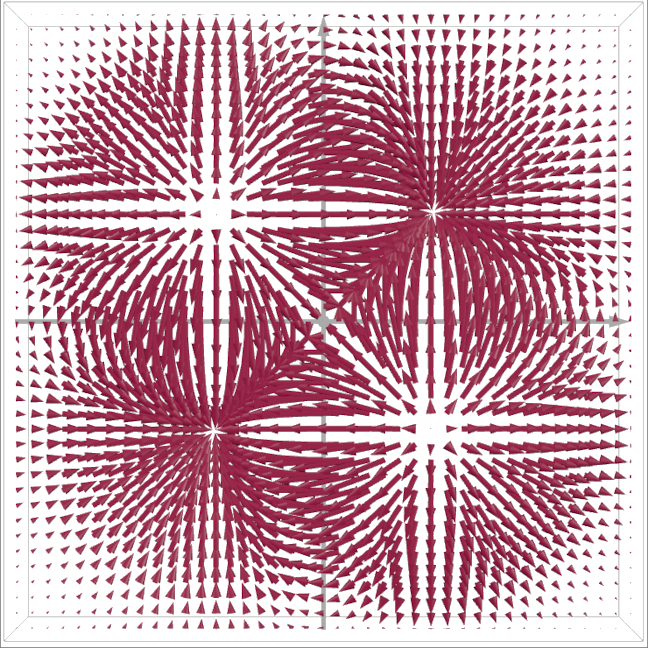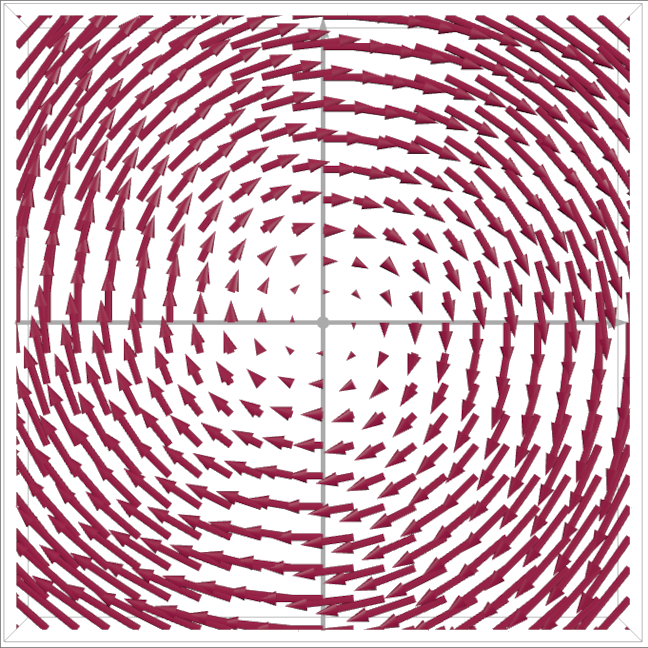A vector field is a multivariable, vector-valued function \(\bm{F}\colon \mathbf{R}^3 \to \mathbf{R}^3\) that assigns a vector to each point in space. A vector field is often written out in terms of its individual component functions \(L\) and \(M\) and \(N\) which are sometimes referred to as scalar fields. Explicitly \({\bm{F}(x,y,z) = L(x,y,z)\mathbf{i} + M(x,y,z)\mathbf{j} + N(x,y,z)\mathbf{k}.}\) More concisely \({F= \bigl\langle L, M, N\bigr\rangle.}\) For a two-dimensional vector field \(N\) is omitted.
 The gradient \(\nabla f\) of a scalar-valued function \(f\)
presents a vector field called the gradient field of \(f.\)
\[
%\nabla f(x,y) = f_x(x,y)\mathbf{i} + f_y(x,y)\mathbf{j}
%\qquad
\nabla f(x,y,z) = f_x(x,y,z)\mathbf{i} + f_y(x,y,z)\mathbf{j} + f_z(x,y,z)\mathbf{k}
\,.
\]
A vector field \(\bm{F}\) is called conservative
(or irrotational or curl-free or longitudinal)
if it is the gradient vector field of some function \(f.\)
For \(\bm{F} = \nabla f\) we call \(f\) a scalar potential of \(\bm{F}.\)
Per Clairaut’s theorem, if a vector field is conservative
the mixed partials of its components will be equal:
\({\tfrac{\partial L}{\partial y} = \tfrac{\partial M}{\partial x}}\)
and \({\tfrac{\partial L}{\partial z} = \tfrac{\partial N}{\partial x}}\)
and \({\tfrac{\partial M}{\partial z} = \tfrac{\partial N}{\partial y}.}\)
The primary examples of conservative vector fields are gravitational force fields,
in which the work done by a particle moving between two points in the field
will be independent of the path it takes from one point to the other;
the total energy within a conservative vector field is conserved.
The gradient \(\nabla f\) of a scalar-valued function \(f\)
presents a vector field called the gradient field of \(f.\)
\[
%\nabla f(x,y) = f_x(x,y)\mathbf{i} + f_y(x,y)\mathbf{j}
%\qquad
\nabla f(x,y,z) = f_x(x,y,z)\mathbf{i} + f_y(x,y,z)\mathbf{j} + f_z(x,y,z)\mathbf{k}
\,.
\]
A vector field \(\bm{F}\) is called conservative
(or irrotational or curl-free or longitudinal)
if it is the gradient vector field of some function \(f.\)
For \(\bm{F} = \nabla f\) we call \(f\) a scalar potential of \(\bm{F}.\)
Per Clairaut’s theorem, if a vector field is conservative
the mixed partials of its components will be equal:
\({\tfrac{\partial L}{\partial y} = \tfrac{\partial M}{\partial x}}\)
and \({\tfrac{\partial L}{\partial z} = \tfrac{\partial N}{\partial x}}\)
and \({\tfrac{\partial M}{\partial z} = \tfrac{\partial N}{\partial y}.}\)
The primary examples of conservative vector fields are gravitational force fields,
in which the work done by a particle moving between two points in the field
will be independent of the path it takes from one point to the other;
the total energy within a conservative vector field is conserved.
 In contrast, a vector field \(\bm{F}\) is called solenoidal
(or incompressible or divergence-free or transversal)
if it “has no sources or sinks.”
An illustrative example of a solenoidal vector field
is the velocity field of any incompressible fluid:
the field flows through points and around points, but not into or out of points;
from nowhere does it generate and towards nowhere does it dissipate.
Other important examples include any magnetic field (\(\bm{B}\)),
or any electric field (\(\bm{E}\)) in a neutral region
where the electric charge density is zero.
In contrast, a vector field \(\bm{F}\) is called solenoidal
(or incompressible or divergence-free or transversal)
if it “has no sources or sinks.”
An illustrative example of a solenoidal vector field
is the velocity field of any incompressible fluid:
the field flows through points and around points, but not into or out of points;
from nowhere does it generate and towards nowhere does it dissipate.
Other important examples include any magnetic field (\(\bm{B}\)),
or any electric field (\(\bm{E}\)) in a neutral region
where the electric charge density is zero.